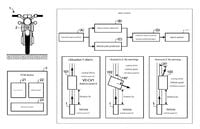Motorcycle-mounted radar systems to enable adaptive cruise control and collision warning are becoming increasingly commonplace, and Honda is working on its own stereo camera-based take on the idea. Another company working on the technology is Yamaha, which just filed a set of patent applications to achieve the same results with nothing more than a single front-facing camera.
Radars are already the bedrock of a lot of advanced driver-assistance systems (ADAS) in the car world, used to monitor other traffic and measure distances and closing speeds to trigger a variety of warnings and accident-evasion systems. Meanwhile, some companies—like Tesla—prefer to use cameras and image recognition software to achieve the same results. However, most camera-based systems, including one shown by Honda’s Astemo subsidiary last year, tend to use more than one camera to create a stereoscopic image, creating the same sort of depth-perception we get from our eyes so the on-board computers can work out how far away objects are.
Yamaha’s design, revealed in two new patent applications in Japan, uses a single camera—so it can’t triangulate the positions of objects—and relies on software to work out the distance, speed, and trajectory of other vehicles in front of the bike.
Why use one camera? It’s likely to be down to cost, although camera sensors are increasingly cheap, but also because the front of a motorcycle—and particularly a traditional naked bike like the one simplistically illustrated in Yamaha’s patent—doesn’t have a lot of space to mount multiple lenses. The images from that single camera are fed to the bike’s computer, along with data about the bike’s speed and yaw rate, and by comparing each image with the previous frames it can estimate the path that the bike will follow for the next few seconds and the paths of the vehicles ahead, triggering a front collision warning if those paths are set to converge.
Related: Indian Working On Next-gen ARAS
The predictive element of the system is key to its operation, but also a potentially significant step forward compared to some older, radar-based ADAS. If you’ve driven a car with forward collision warning (FCW), there’s a good chance you’ll have experienced a false alarm. A common cause, for example, is when there’s a slower moving vehicle ahead that’s already pulling out of the way. You know he’ll be gone by the time you get there, so there’s no reason to brake, but the ADAS doesn’t, and triggers an alert. Yamaha’s single-camera system, as shown in its patents, would be able to account for that by working out where the target vehicle will be, so false alarms would be kept to a minimum.
Another situation illustrated in the patent is a vehicle safely crossing the road ahead of you, perhaps traveling in the opposite direction and turning left into a side street. Again, you know that they’ll complete the move before you reach them, so there’s no need to slow, but a simpler ADAS system might not recognize that fact and could trigger a warning.
The system can also work out your own trajectory based on lean angle (unlike a car which might use steering wheel angle to predict your intended course), and that means it can also detect if a vehicle that isn’t directly ahead of you is going to come into conflict in the near future. The example here would be a slow-moving vehicle ahead on a curving road. A dumber ARAS might ignore the hazard, as it’s not directly in front of your bike, but the Yamaha system would understand that because the road is turning, the vehicle is actually in your path even though it’s not directly in front.
Too much tech? There’s certainly an argument that we’re better off relying on our own senses instead of cameras and computers, but the more effectively false alarms can be weeded out from the systems, the less intrusive and annoying they will become, coming closer to fulfilling the real intention of preventing crashes.










/cloudfront-us-east-1.images.arcpublishing.com/octane/CZ5OM3E43ZEXJHY7LCYXCHLIKI.jpg)


/cloudfront-us-east-1.images.arcpublishing.com/octane/M2YIBOC7HNDRTJAFCEMELX4HME.jpg)
/cloudfront-us-east-1.images.arcpublishing.com/octane/UWTN4NTIJFD25MPXBOVS4DFOXE.jpg)
/cloudfront-us-east-1.images.arcpublishing.com/octane/SIFOY54XMFGEHAUYNFUYVW7IZ4.jpg)
/cloudfront-us-east-1.images.arcpublishing.com/octane/HMC5X3JZHRASXGVCVNBJBWWGSI.jpg)
/cloudfront-us-east-1.images.arcpublishing.com/octane/UIWGXRZDM5HZXJOWXET2DZIWJE.jpg)
/cloudfront-us-east-1.images.arcpublishing.com/octane/QSS5DZ6SKJEU3AKE4KDAWYBEFY.jpg)
/cloudfront-us-east-1.images.arcpublishing.com/octane/SMCEQCLWRVEFTJJES6TAHB3OOQ.jpg)
/cloudfront-us-east-1.images.arcpublishing.com/octane/JCACIDCAC5FUNPTXO2BOUHGGII.jpg)
/cloudfront-us-east-1.images.arcpublishing.com/octane/DC7ZGILA2BCJXHZIUNYGV7JSEA.jpg)
/cloudfront-us-east-1.images.arcpublishing.com/octane/EWJEZUGWEZGABDEQWB64WL46GQ.jpg)
/cloudfront-us-east-1.images.arcpublishing.com/octane/5NHBMRMSFVD5JAPFNMBMNPGXQE.jpg)
/cloudfront-us-east-1.images.arcpublishing.com/octane/WHE43SCPLJBRNANAJAGXHOAIEU.jpg)
/cloudfront-us-east-1.images.arcpublishing.com/octane/6R56AQAW6NDE7BBIJ3SMCOOY5A.jpg)
/cloudfront-us-east-1.images.arcpublishing.com/octane/JMQTUE2FKZFURJTJXDMM4V47AQ.jpg)
/cloudfront-us-east-1.images.arcpublishing.com/octane/P2QYJDMQNVEANMQFXHNB3OVFKQ.jpg)
/cloudfront-us-east-1.images.arcpublishing.com/octane/VNKGXM4AA5BPRGERJOPV6GADAQ.jpg)
/cloudfront-us-east-1.images.arcpublishing.com/octane/2WS4YIFLTNG25L25WP7ZFLSWJM.jpg)
/cloudfront-us-east-1.images.arcpublishing.com/octane/UXRS6ZVQZFC23FY2EDYNT5WMVA.jpg)
/cloudfront-us-east-1.images.arcpublishing.com/octane/7JETMCKNVRGDZIGB3JCITGLPUU.jpg)
/cloudfront-us-east-1.images.arcpublishing.com/octane/OZV6E2KNIJDVHGOKXQQ2AHKLHQ.jpg)
/cloudfront-us-east-1.images.arcpublishing.com/octane/XSKMIBFZIZDN7JC6P7SMNMD3QA.jpg)
/cloudfront-us-east-1.images.arcpublishing.com/octane/ITVHWHVQ75BQBHACERYDJLPLHE.jpg)
/cloudfront-us-east-1.images.arcpublishing.com/octane/M3QRBSQ4VFEVPKYTTM3OETVFBU.jpg)
/cloudfront-us-east-1.images.arcpublishing.com/octane/H3EMT5NJ5BDZPBBH27SW3ADQH4.jpg)
/cloudfront-us-east-1.images.arcpublishing.com/octane/XTROSHDZFJB5DIJYU2VF2REFIU.jpg)